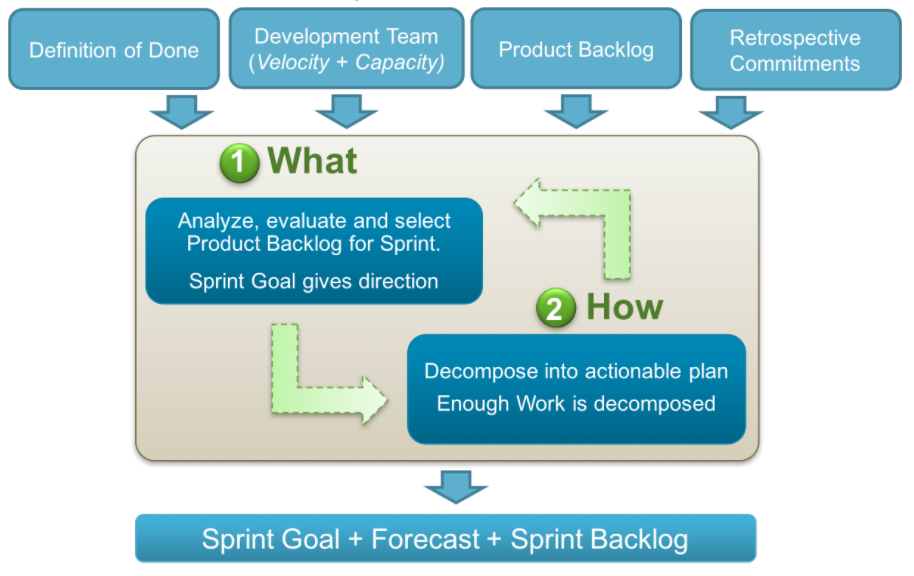








Many people misunderstand that Agile and Scrum Framework are the same. However, Scrum is one of the frameworks of Agile. Scrum is an agile framework that helps teams work together and tackle complicated issues, whilst they can ensure delivery schedule and productivity of product development with the highest possible value.
Scrum is popular because it is a simple framework that generates effective collaboration between team members when working on complicated projects. In general, the product of the project is usually divided into different parts or stages (sprints). The sprint takes place regularly and its benefit is to facilitate the teams to change and adjust the most suitable solutions and results.
A Scrum development team will have slightly different components from the traditional Waterfall model, with the following three roles:
– Product owner
– Development Team
Sprints require the Scrum team to have a multi-functional team, the development team will include Testers, Designers, and Ops Engineers.
The Scrum Framework process organizes events that help the development team complete their tasks with high regularity. Simultaneously, Scrum reduces unnecessary meetings and shortens the time for argument or irrelevant discussion. When one sprint starts, the period for each sprint is regularly fixed. The other events can be finished if the goal of the event is completed.This factor helps the development team manage their work well within a suitable amount of timeframe. There are 5 events in the Scrum process:
Is the duration in which the Scrum Team can conduct all necessary tasks to produce a transferable part of the product. The time-box of the sprint is usually around 1 month or less. Sprints are contiguous without interruption.
During the Sprint:
– Sprint Goal is unchangeable;
– The Development Team is consistent;
– Quality objectives are not reduced;
– Product Owner and the Development Team can renegotiate the scope
Is the planning session for the next Sprint. This is the time the whole teamwork and discusses goals, potential risks, solutions, and detailed planning for the next step.
Sprint Planning answers the following:
– What is the purpose of this Sprint?
– What will we deliver?
– How to achieve the expected result?

In this event, the Scrum Master has responsibility for guaranteeing to take place the event. In addition, the Scrum Master has to clarify the purpose and goals of the Sprint so that the development team can clearly understand them.
Moreover, the timebox is another essential element of meetings. The team should schedule every Sprint Planning meeting and ensure it lasts for a reasonable amount of time. This helps the team shorten meeting time but ensures the value and quality of the meeting for Sprints.
In some businesses, the daily standup meeting is a short discussion or meeting with a 15-minute time-boxed event where the Development Team reports and synchronizes work among members. The Development Team considers this event as the re-planning meeting. Furthermore, the team collaboratively discusses issues, defines solutions, and suggests new plans for Sprints. While the Daily Scrum is typically for the Development team, other teams can participate in some cases and according to business rules to maximize collaboration.
Learn more: How to run an effective Daily Scrum Meeting?
This is the meeting that takes place at the end of each Sprint to inspect the Increment and adapt the Product Backlog. For a 1 month Sprint, there are 4 hours for a Sprint review
The main attendees include the Development Team, the Scrum Master, the Product Owner, and the stakeholders. In this review meeting, the team can share demos or let users experience the product to accumulate feedback. The Scrum team and stakeholders will collaboratively determine what has been accomplished and what remains outstanding. All team collaborates about what to do next to maximize the value of the product based on changes and issues during the Sprint. In some businesses, the review meeting also includes many aspects that can impact the value of the product. In particular, they will review the marketplace and its potential to define what they should change or enhance features.
Many people misunderstand that Agile and Scrum Framework are the same. However, Scrum is one of the frameworks of Agile. Scrum is an agile framework that helps teams work together and tackle complicated issues, whilst they can ensure delivery schedule and productivity of product development with the highest possible value.
Scrum is popular because it is a simple framework that generates effective collaboration between team members when working on complicated projects. In general, the product of the project is usually divided into different parts or stages (sprints). The sprint takes place regularly and its benefit is to facilitate the teams to change and adjust the most suitable solutions and results.
A Scrum development team will have slightly different components from the traditional Waterfall model, with the following three roles:
– Product owner
– Scrum Master
– Development Team
Sprints require the Scrum team to have a multi-functional team, the development team will include Testers, Designers, and Ops Engineers.
Scrum is well known for its flexibility in the process. All processes give the development team a chance to make innovations and changes based on client requirements and the marketplace consecutively. The team can also shorten the duration of the project.
Particularly, Scrum allows the team to be creative and innovative in deploying their product while keeping them on track. Scrum is easy for a team to learn and implement in real cases as fast as possible.
In addition to minimizing risks and issues, the development team can work with high efficiency and productivity for consecutive enhancement. Here are some key reasons why Scrum is popular:
Scrum Framework has proven to be a powerful approach in software development, enabling teams to work efficiently, adapt to changes, and consistently deliver high-quality products. Its popularity is attributed to its flexibility, iterative process, and focus on collaboration and continuous improvement.
ITC Group recognizes the value of the Scrum Framework in driving successful project outcomes. By leveraging Scrum’s agile approach, ITC Group empowers its teams to innovate, collaborate effectively, and deliver exceptional solutions to clients.
As businesses continue to evolve in today’s fast-paced digital landscape, embracing the Scrum Framework can be a game-changer. Whether you are looking to enhance productivity, improve product quality, or increase customer satisfaction, Scrum provides a robust framework to achieve your goals.
Stay ahead in a rapidly changing world with our monthly look at the critical challenges confronting businesses on a global scale, sent straight to your inbox.